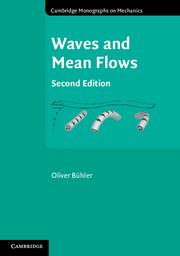Book contents
- Frontmatter
- Dedication
- Contents
- Preface
- PART ONE FLUID DYNAMICS AND WAVES
- PART TWO WAVE–MEAN INTERACTION THEORY
- 5 Zonally symmetric wave–mean interaction theory
- 6 Internal gravity waves
- 7 Shear flows
- 8 Three-dimensional rotating flow
- 9 Rossby waves and balanced dynamics
- 10 Lagrangian-mean theory
- 11 Zonally symmetric GLM theory
- PART THREE WAVES AND VORTICES
- References
- Index
6 - Internal gravity waves
Published online by Cambridge University Press: 05 April 2014
- Frontmatter
- Dedication
- Contents
- Preface
- PART ONE FLUID DYNAMICS AND WAVES
- PART TWO WAVE–MEAN INTERACTION THEORY
- 5 Zonally symmetric wave–mean interaction theory
- 6 Internal gravity waves
- 7 Shear flows
- 8 Three-dimensional rotating flow
- 9 Rossby waves and balanced dynamics
- 10 Lagrangian-mean theory
- 11 Zonally symmetric GLM theory
- PART THREE WAVES AND VORTICES
- References
- Index
Summary
We study the Boussinesq system, which is the simplest fluid model that admits internal gravity waves. These dispersive waves are ubiquitous in the atmosphere and ocean and they owe their restoring mechanism to the stable stratification in these environments, i.e., to the fact that density decreases with altitude. Internal gravity waves are typically far too small in scale (especially vertical scale) to be resolvable within global numerical models and therefore their dynamics and their interactions with the mean flow must be parametrized (i.e., put in by hand) based on a combination of observations and theory. Consequently, the classic wave-mean interaction theory for internal gravity waves has been extensively developed and this provides a convenient starting point for us.
Boussinesq system and stable stratification
The simplest fluid model that captures the effect of stable internal stratification is the Boussinesq model, which can be derived from the Euler equations and its dissipative counterparts under the assumption of a small density contrast across the fluid, together with ∇ . u = 0. Importantly, the latter constraint filters sound waves and thereby reduces the number of degrees of freedom compared to the full Euler system.
Before writing down the governing equations we note that as a realistic model for atmospheric and oceanic flows the Boussinesq system is mostly limited by its global restriction to small density contrasts across the fluid, and that these limitations are much more severe in the atmosphere than in the ocean.
- Type
- Chapter
- Information
- Waves and Mean Flows , pp. 107 - 147Publisher: Cambridge University PressPrint publication year: 2014

